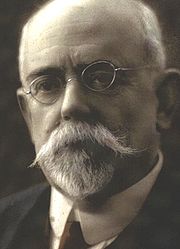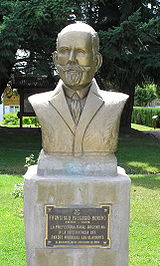
Francisco Moreno
Encyclopedia

Argentina
Argentina , officially the Argentine Republic , is the second largest country in South America by land area, after Brazil. It is constituted as a federation of 23 provinces and an autonomous city, Buenos Aires...
, where he is usually referred to as Perito Moreno (perito means "specialist, expert"). Perito Moreno has been credited as one of the most influential figures in the Argentine incorporation of large parts of Patagonia.
Life and work
Moreno was born to Francisco and Juana Thwaites Madero in Buenos AiresBuenos Aires
Buenos Aires is the capital and largest city of Argentina, and the second-largest metropolitan area in South America, after São Paulo. It is located on the western shore of the estuary of the Río de la Plata, on the southeastern coast of the South American continent...
. Raised in a traditional patrician family, he studied in local parochial school
Parochial school
A parochial school is a school that provides religious education in addition to conventional education. In a narrower sense, a parochial school is a Christian grammar school or high school which is part of, and run by, a parish.-United Kingdom:...
s. He shared his spare time with his father searching for artifacts and fossils, and at age 14, created a homemade museum of his extensive collections. Following graduation in 1872, he participated in the establishment of the Argentine Scientific Society, and embarked on the first of the series of expeditions that made him well known: a survey of Río Negro Territory
Río Negro Province
Río Negro is a province of Argentina, located at the northern edge of Patagonia. Neighboring provinces are from the south clockwise Chubut, Neuquén, Mendoza, La Pampa and Buenos Aires. To the east lies the Atlantic Ocean.Its capital is Viedma...
, largely uncharted territory which had recently been made accessible by the controversial Conquest of the Desert
Conquest of the Desert
The Conquest of the Desert was a military campaign directed mainly by General Julio Argentino Roca in the 1870s, which established Argentine dominance over Patagonia, which was inhabited by indigenous peoples...
campaign. In January 1876, he reached Lake Nahuel-Huapi, in the southern Andes
Andes
The Andes is the world's longest continental mountain range. It is a continual range of highlands along the western coast of South America. This range is about long, about to wide , and of an average height of about .Along its length, the Andes is split into several ranges, which are separated...
, and discovered, on February 14, 1877, Lake San Martín. He also explored numerous rivers in Patagonia
Patagonia
Patagonia is a region located in Argentina and Chile, integrating the southernmost section of the Andes mountains to the southwest towards the Pacific ocean and from the east of the cordillera to the valleys it follows south through Colorado River towards Carmen de Patagones in the Atlantic Ocean...
, and on March 4, he discovered El Chaltén
El Chaltén
El Chaltén is a small mountain village in Santa Cruz Province, Argentina. It is located in the riverside of Río de las Vueltas, within the Los Glaciares National Park at the base of Cerro Torre and Cerro Fitz Roy mountains, both popular for climbing...
mountain, which he renamed Fitz Roy.

Patagonia
Patagonia is a region located in Argentina and Chile, integrating the southernmost section of the Andes mountains to the southwest towards the Pacific ocean and from the east of the cordillera to the valleys it follows south through Colorado River towards Carmen de Patagones in the Atlantic Ocean...
, where he was taken prisoner by a Tehuelche aboriginal tribe and condemned to death, but escaped on March 11, one day before the appointed execution. In 1882–1883 he explored the Andes from Bolivia
Bolivia
Bolivia officially known as Plurinational State of Bolivia , is a landlocked country in central South America. It is the poorest country in South America...
southward, and in 1884–1885 he made new explorations of the territory south of the Río Negro and of Patagonia. He was director of the anthropological museum of Buenos Aires, chief of the Argentine exploring commission of the southern territories, and member of numerous European scientific societies.
For his contributions to science, Moreno received a doctorate Honoris causa from the National University of Córdoba
National University of Córdoba
The National University of Córdoba, , is the oldest university in Argentina, and one of the oldest in the Americas. It is located in Córdoba, the capital of Córdoba Province. Since the early 20th century it has been the second largest university in the country in terms of the number of students,...
in 1877. He is also known for his role in defending Argentine interests and his defining surveys leading to the Boundary treaty of 1881 between Chile and Argentina. These surveys and others yielded Moreno a vast collection of archaeological and anthropological findings, for which he created a museum in Buenos Aires in 1877. The institution was incorporated in 1888 into the La Plata Museum of Natural History
La Plata Museum
The La Plata Museum is a natural history museum in La Plata, Argentina.The building, 135 meters long, today houses 3 million fossils and relics , an amphitheatre, opened in 1992, and a 58,000-volume library, serving over 400 university researchers...
, the most important of its kind in South America, and of which he served as the first Director, until 1906.
Moreno was appointed Perito (a technical specialist or expert) in 1902, in which capacity he disproved Chilean claims to the continental divide
Continental divide
A continental divide is a drainage divide on a continent such that the drainage basin on one side of the divide feeds into one ocean or sea, and the basin on the other side either feeds into a different ocean or sea, or else is endorheic, not connected to the open sea...
. Moreno proved that many Patagonia
Patagonia
Patagonia is a region located in Argentina and Chile, integrating the southernmost section of the Andes mountains to the southwest towards the Pacific ocean and from the east of the cordillera to the valleys it follows south through Colorado River towards Carmen de Patagones in the Atlantic Ocean...
n lakes draining to the Pacific Ocean
Pacific Ocean
The Pacific Ocean is the largest of the Earth's oceanic divisions. It extends from the Arctic in the north to the Southern Ocean in the south, bounded by Asia and Australia in the west, and the Americas in the east.At 165.2 million square kilometres in area, this largest division of the World...
were in fact part of the Atlantic Ocean
Atlantic Ocean
The Atlantic Ocean is the second-largest of the world's oceanic divisions. With a total area of about , it covers approximately 20% of the Earth's surface and about 26% of its water surface area...
basin, but had been moraine-dammed during the quaternary
Quaternary
The Quaternary Period is the most recent of the three periods of the Cenozoic Era in the geologic time scale of the ICS. It follows the Neogene Period, spanning 2.588 ± 0.005 million years ago to the present...
glaciations, changing their outlets to the west.
In 1903, Moreno donated some of the land previously given to him for the creation of the Nahuel Huapi National Park
Nahuel Huapi National Park
Established in 1934, the Nahuel Huapi National Park is the oldest national park in Argentina. It surrounds Nahuel Huapi Lake in the foothills of the Patagonian Andes. The largest of the national parks in the region, it has an area of , or nearly 2 million acres...
. The Perito Moreno Glacier
Perito Moreno Glacier
The Perito Moreno Glacier is a glacier located in the Los Glaciares National Park in the south west of Santa Cruz province, Argentina. It is one of the most important tourist attractions in the Argentine Patagonia....
and the town of Perito Moreno, all in Santa Cruz Province
Santa Cruz Province (Argentina)
Santa Cruz is a province of Argentina, located in the southern part of the country, in Patagonia. It borders Chubut province to the north, and Chile to the west and south. To the east is the Atlantic Ocean...
, are named after him. He was appointed Assistant Director of the National Education Council in 1911 and helped secure funding for the Bernasconi Institute
Bernasconi Institute
The Bernasconi Institute is an architecturally-significant primary school in the Parque Patricios section of Buenos Aires.-Overview:An estate on an eight-hectare property in Buenos Aires' southside became the site of a homemade museum in 1866, when 14-year-old Francisco Moreno and his father...
, a landmark primary school built in Buenos Aires on land he sold to Swiss Argentine industrialist Félix Bernasconi; its archaeological and natural history museums were created in part with his extensive collections of artifacts.
He established the Scouting and Guiding in Argentina, the Argentine Boy Scouts Association in 1912, and joined former U.S. President Theodore Roosevelt
Theodore Roosevelt
Theodore "Teddy" Roosevelt was the 26th President of the United States . He is noted for his exuberant personality, range of interests and achievements, and his leadership of the Progressive Movement, as well as his "cowboy" persona and robust masculinity...
in a tour of Patagonia. Continuing to oversee the La Plata Museum
La Plata Museum
The La Plata Museum is a natural history museum in La Plata, Argentina.The building, 135 meters long, today houses 3 million fossils and relics , an amphitheatre, opened in 1992, and a 58,000-volume library, serving over 400 university researchers...
well after his official retirement, political developments in later years led Moreno to join the reactionary Argentine Patriotic League
Argentine Patriotic League
The Argentine Patriotic League was a Nacionalista paramilitary group, officially created in Buenos Aires on January 16, 1919, during the Tragic week events. Presided over by Manuel Carlés, a professor at the Military College and the Escuela Superior de Guerra, it also counted among its members the...
shortly before his death in 1919. Moreno's remains were transferred from a La Recoleta Cemetery
La Recoleta Cemetery
La Recoleta Cemetery is a famous cemetery located in the exclusive Recoleta neighbourhood of Buenos Aires, Argentina. It contains the graves of notable people, including Eva Perón, Raúl Alfonsín, and several presidents of Argentina.- History :...
crypt to Centinela Isle, in Lake Nahuel Huapi, in 1944.
External links
- Biography (Spanish)
- Biography (Spanish)
- His statue

